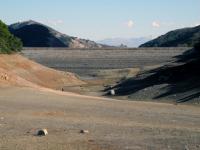-
Ground-breaking discovery for world food security
Researchers have made a discovery that could help conquer the greatest threat to global food security – pests and diseases in plants. The researchers say this could be a game-changer for crop protection. “In agriculture, the need for new control agents grows each year, driven by demand for greater production, the effects of climate change, community and regulatory demands, and toxicity and pesticide resistance,” one researcher said.
-
-
Whitefly: a formidable threat to food security
Researchers have sequenced the genome of the whitefly (Bemisia tabici), an invasive insect responsible for spreading plant viruses worldwide, causing billions of dollars in crop losses each year. The genome study offers many clues to the insect’s remarkable ability to resist pesticides, transmit more than 300 plant viruses, and to feed on at least 1,000 different plant species.
-
-
Dust Bowl would devastate today’s crops: Study

A drought on the scale of the legendary Dust Bowl crisis of the 1930s would have similarly destructive effects on U.S. agriculture today, despite technological and agricultural advances, a new study finds. Additionally, warming temperatures could lead to crop losses at the scale of the Dust Bowl, even in normal precipitation years by the mid-twenty first century.
-
-
Developing the National Livestock Readiness Program
The National Agricultural Biosecurity Center has received $331,118 from the Department of Homeland Security through its Basic Ordering Agreement with K-State to develop the National Livestock Readiness Program. The project, with its initial deliverables completed by September 2017, will provide a clearinghouse for planning, training, and knowledge products to help state and local entities prepare for transboundary livestock disease outbreaks.
-
-
Common grass to help boost food security
Common Panic grasses could hold the secret to increasing the yields of cereal crops and help feed the world with increasing temperature extremes and a population of nearly ten billion people by 2050. The grasses have the potential to improve crop yields for staple foods such as wheat and rice by transplanting enzymes from Panic grasses.
-
-
Economic impact of inland waterway disruptions potentially in the billions
What would happen if a lengthy disruption befell the major mode of transportation of U.S. corn and soybeans? What ramifications would that have on U.S. producers and the national economy? How would that affect U.S. competitiveness in world grain markets? While hypothetical, these concerns are very real as the barge corridor in question contains a total of thirty-six locks and dams that have long since surpassed their designed lifespan. This corridor is the Upper Mississippi River and Illinois Waterway (UMR-IWW) that serves as the primary corridor for the movement of bulk commodities in the United States. Corn and soybeans comprise nearly 90 percent of food and farm products on these waterways.
-
-
Food for thought: Including agriculture in biosecurity and biodefense
From agriculture to animal health, Kansas State University has been on the forefront of the national discussion in bio/agrodefense since it published the Homeland Defense Food Safety, Security and Emergency Preparedness Program — also known as “The Big Purple Book” — in 1999. Recently, the university co-hosted an event at the Bipartisan Policy Center, highlighted the threat of bio/agroterrorism and the importance of including agriculture in biosecurity and biodefense.
-
-
First in-port insect discovery by CBP in San Juan
An entomologist from the U.S. Department of Agriculture (USDA) confirmed recently that Customs and Border Protection (CBP) agriculture specialists made a first in port discovery of an insect within an imported air cargo shipment of cut flowers arriving from Bogota, Colombia. CBP says that the Guayaquila pallescens, commonly called treehoppers or thorn bugsis the first of its species intercepted in Puerto Rico.
-
-
DARPA enlists insects to protect agricultural food supply, commodity crops
It may not be obvious to humans, but the life of a plant is full of peril. Viruses, pests, fungi, herbicides, drought, pollution, salinity, flooding, and frost — the plants that we depend on for food, clean air, and materials are challenged by myriad threats, natural and man-made. A new DARPA program is poised to provide an alternative to traditional agricultural threat response, using targeted gene therapy to protect mature plants within a single growing season.
-
-
Even if the Paris Agreement is implemented, food and water supplies remain at risk
If all pledges made in last December’s Paris climate agreement (COP21) to curb greenhouse gases are carried out to the end of the century, then risks still remain for staple crops in major “breadbasket” regions and water supplies upon which most of the world’s population depend. Recognizing that national commitments made in Paris to reduce greenhouse gas emissions fall far short of COP21’s overarching climate target — to limit the rise, since preindustrial times, in the Earth’s mean surface temperature to 2 degrees Celsius by 2100 — a new report advances a set of emissions scenarios that are consistent with achieving that goal.
-
-
Megadrought lasting three decades likely for Southwest U.S., Midwest

The consequences of climate change paint a bleak picture for the Southwest and much of America’s breadbasket, the Great Plains. The role of climate change in causing extreme heat waves, drastic rainfall, negative impacts on human health, and threatened food security have received more attention recently than megadrought, but scientists view prolonged drought risk as yet another natural hazard that becomes more likely from human activity.
-
-
Climate change means land use will need to change to keep up with global food demand
Researchers warn that without significant improvements in technology, global crop yields are likely to fall in the areas currently used for production of the world’s three major cereal crops — wheat, maize, and rice — forcing production to move to new areas. This could lead to a major drop in productivity of these areas by 2050, along with a corresponding increase in potential productivity of many previously unused areas, pointing to a major shift in the map of global food production.
-
-
UN’s Sustainable Development Goals: Wicked trade-offs between environmental, food security goals
As world leaders gather in New York for the UN General Assembly, one year after the formal adoption of the UN’s Sustainable Development Goals (SDGs), a new study finds that policies focused solely on the environment tend to increase food prices. However, the study goes on to identify sustainable consumption and production practices as key to achieving both environmental and food security targets simultaneously.
-
-
Solar-powered Ring Garden combines desalination, agriculture for drought-stricken California
With roughly 80 percent of California’s already-scarce water supply going to agriculture, it is crucial for the state to embrace new technologies that shrink the amount of water required to grow food. Alexandru Predonu has designed an elegant solution which uses solar energy to power a rotating desalination plant and farm that not only produces clean drinking water for the city of Santa Monica, but also food crops — including algae.
-
-
Robot, drones to help collect crop testing data to bolster agricultural production
A rumbling robot and several high-flying drones recently made an on-site appearance at Clemson University to burrow through and buzz above fifteen acres of experimental sorghum plots containing more than 2,800 replicated entries. The space-age devices are part of a collaborative project with Clemson University and other partners designed to significantly enhance the ease and frequency of data collection for crop testing in ways that will eventually benefit all agricultural production in South Carolina and around the world.
-
- All
- Regional
- Water
- Biometrics
- Borders/Immig
- Business
- Cybersecurity
- Detection
- Disasters
- Government
- Infrastructure
- International
- Public health
- Public Safety
- Communication interoperabillity
- Emergency services
- Emergency medical services
- Fire
- First response
- IEDs
- Law Enforcement
- Law Enforcement Technology
- Military technology
- Nonlethal weapons
- Nuclear weapons
- Personal protection equipment
- Police
- Notification /alert systems
- Situational awareness
- Weapons systems
- Sci-Tech
- Sector Reports
- Surveillance
- Transportation
Advertising & Marketing: advertise@newswirepubs.com
Editorial: editor@newswirepubs.com
General: info@newswirepubs.com
2010-2011 © News Wire Publications, LLC News Wire Publications, LLC
220 Old Country Road | Suite 200 | Mineola | New York | 11501
Permissions and Policies
Editorial: editor@newswirepubs.com
General: info@newswirepubs.com
2010-2011 © News Wire Publications, LLC News Wire Publications, LLC
220 Old Country Road | Suite 200 | Mineola | New York | 11501
Permissions and Policies
